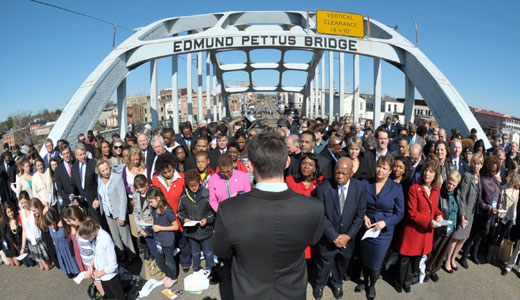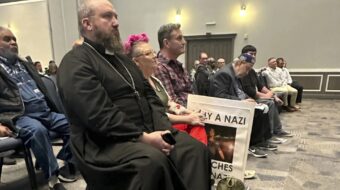
Several thousand union members, civil rights activists, community organizers, religious leaders, and others have opened a five-day series of events tracing closely the historic 1965 Selma to Montgomery, Ala. civil rights march.
The kickoff was on the Edmund Pettus Bridge in Selma, Alabama Mar. 4, the place where Bloody Sunday took place 47 years ago. People marching for their constitutional right to vote were brutally beaten that day by Alabama state troopers.
Organizers say that, more than a commemoration, the march this week is a demonstration against modern day attacks, not just on voting rights, but on immigrant rights and workers rights.
The AFL-CIO is calling upon people who can’t be at the march to click here to sign a pledge of solidarity with the marchers and join a virtual march.
Union activists at the march will share the tens of thousands of online comments they expect from across the country with those actually making the cross-country trek.
Rep. John Lewis, D-Ga., an Alabama native and now a veteran member of Congress, had his head cracked open by troopers on the bridge in Selma 47 years ago.
Addressing a huge crowd Saturday in Montgomery, Lewis praised the positioning of a historic marker at the bottom of the steps of the state capital there. Because of the marker, “generations yet unborn can understand what happened and how it happened; people should embrace it,” he declared.
The marker is just downhill from a giant statue of Confederate President Jefferson Davis. Lewis said the positioning illustrates how much times have changed.
“The distance we’ve come and the progress we’ve made is evident here today,” Lewis said, “The governor back then (George Wallace) wouldn’t let us come to the steps of the Capitol.”
When the marchers who had left Selma arrived in Montgomery on March 25, 1965, they were joined by tens of thousands of others who jammed the streets to hear the Rev. Martin Luther King Jr. deliver one of his famous speeches.
The first full day of events began this morning with several hundred marchers starting out from the famous bridge. Determined to meet what they say are new challenges to civil rights today, they were led by the Rev. Al Sharpton, founder of the National Action Network, Ben Jealous, president of the NAACP, the Rev. Jesse Jackson, and Arlene Holt Baker, executive vice president of the AFL-CIO.
After leaving the bridge marchers headed east on Highway 80 and expected to finish the first 12 miles of their journey by tonight. They expect to reach Montgomery by Friday where they will rally on the steps of the state capital.
Marchers say voting rights is again a major issue because voters in many states face obstacles from new laws originally drafted by the American Legislative Exchange Council, an outfit funded by Charles and David Koch and other billionaires.
The ALEC draft law inspired a slew of recently passed voter ID laws that, if allowed to stand, will weaken the electoral strength of minorities and youth in Texas, South Carolina, Wisconsin, Tennessee, Kansas, Maine, and other states.
In Texas, for example, a college ID is not an acceptable form of voter identification, while a hunting license is.
The marchers are focusing too on Alabama’s HB 56, one of the harshest immigration laws in the country.
William Lucy, president of the Coalition of Black Trade Unionists, travelled to Alabama last November to witness first hand the effects of the law.
“None of us expected to witness the humanitarian crisis we experienced, a crisis that hearkens Alabama back to the bleakest days of the state’s racial history,” Lucy said in December. “The parallels to Jim Crow are all too real, and the prejudice we heard about felt all too familiar.”
Lucy was referring to parents who drop off their children for school saying they didn’t know whether they’d be around to pick them up, to teachers being forced to act as immigration law enforcers rather than as educators, to employers worried their workers may be too afraid to show up on the job, and to a host of similar situations his team witnessed.
The march is yet another example of close coordination between the civil rights and labor movements. Participants see Republican attacks on the right to unionize and on collective bargaining as an attack on the civil rights of working people.
Elizabeth Bunn, AFL-CIO Organizing Director, said recently about the attacks on voting rights and workers rights that “at the end of the day, this is about corporate and CEO control of the economy.” She also says in almost all her speeches on this topic, however, that workers, in or out of unions, have the ability to fight back. Workers, she says, are united when it comes to issues like basic fairness.
Photo: The Congressional Faith & Politics Institute group gathers on the Edmund Pettus Bridge prior the 47th recreation of the “Bloody Sunday” civil rights march from Selma to Montgomery in Selma, Ala., March 4. Kevin Glackmeyer/AP












Comments